Blane Surname Ancestry ResultsOur indexes 1000-1999 include entries for the spelling 'blane'. In the period you have requested, we have the following 161 records (displaying 81 to 90): Single Surname Subscription | | | Buying all 161 results of this search individually would cost £872.00. But you can have free access to all 161 records for a year, to view, to save and print, for £100. Save £772.00. More... |
These sample scans are from the original record. You will get scans of the full pages or articles where the surname you searched for has been found. Your web browser may prevent the sample windows from opening; in this case please change your browser settings to allow pop-up windows from this site. Inhabitants of Berkswell in Warwickshire
(1850)
Francis White & Co.'s History, Gazetteer, and Directory of Warwickshire for 1850 lists nobility, gentry, clergy, other private residents, farmers and traders, hundred by hundred and village by village, with separate sections for the large towns.BLANE. Cost: £6.00.  | Sample scan, click to enlarge

| Gentlemen amateur rowers
(1835-1851)
Rowing was one of the English sports covered in detail in the pages of Bell's Life in London, and from these was compiled a compendium called the Aquatic Oracle. The text is divided into two main parts: Gentlemen Amateurs and Watermen. All the entries are cross-referenced, and use these abbreviations: w., won; l., lost; b., beat; bn., beaten; sc. ma., scullers' match; o. ma., oars match; do. sc. ma., double scullers' match; 4 o.ma., 4 oars match; 8 o. ma., 8 oars match; sk., stroke; cox., coxswain; as., a side; Oxon., Oxonian; V. to P., Vauxhall to Putney; W. to P., Westminster to Putney; P. to M., Putney to Mortlake; M. to P., Mortlake to Putney; dis., distance.BLANE. Cost: £6.00.  | Sample scan, click to enlarge
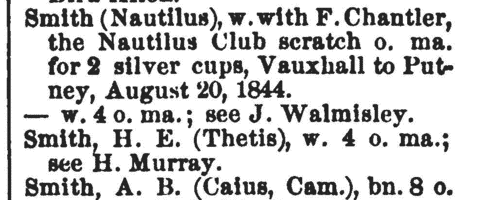
|  Inhabitants of Newington in Surrey
(1851) Inhabitants of Newington in Surrey
(1851)
The 1851 census return for St Mary Newington, Surrey, registration district: St Peter Walworth sub-district: enumeration district 8: described as: "All that Part of the Parish of St. Mary Newington, which Comprises Walworth Common (south side) from Walworth Road to Providence St., Including West side of Providence St., Appleton Place, Charles St., Pilgrim St. (both sides), Port St. (both sides), Milk St. (both sides) and Red Lion Row". This area lay in the ecclesiastical district of St Peter Walworth, and in the borough of Lambeth. HO 107/1567. The addresses listed in the actual returns are 1 to 7 Red Lion Row, Grosvenor Park; 1 to 7 Port Place, Walworth Common; 1 to 27 Milk Street; 1 to 6 Port Place; 2 to 24 Port Street; Port House, Port Street; 1 to 32 Pilgrim Streeet; 1 to 3 Bucknell Place; 1 to 7 Charles Street; 1 to 4 Nuns Place; 1 to 5 Appleton Place; 1 to 6 Boytons Place; 1 to 6 Portland Terrace; and 9 to 18 Providence Street. BLANE. Cost: £4.00.  | Sample scan, click to enlarge

|  Inhabitants of Newington in Surrey
(1851) Inhabitants of Newington in Surrey
(1851)
The 1851 census return for St Mary Newington, Surrey, registration district: St Peter Walworth sub-district: enumeration district 27: described as: "All that Part of the Parish of St. Mary Newington, which Comprises East St. (North side) from Camden St. to Kings Arch Place, Including King St., Queen St., Locks Place, Victoria Place, Brewhouse Place, Cross St., and Lestock Place". This area lay in the ecclesiastical district of St Peter Walworth, and in the borough of Lambeth. HO 107/1567. The addresses listed in the actual returns are 17 to 19 and 24 to 29 East Street; 1 Pleasant Place; 2 to 13 Pleasant Row; 1 to 31 King Street; 1 to 10 Cross Street; 1 to 19 Queen(s) Street; 2 to 15 Locks Place; 1 to 11 Victory Place; 1 to 4 Brewhouse Place; 1 to 12 Upper Cross Street; and 1 to 7 Lestock Place.BLANE. Cost: £4.00.  | Sample scan, click to enlarge
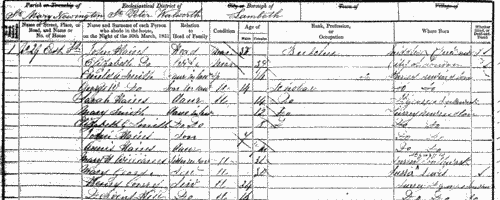
|  Inhabitants of Southwark in Surrey
(1851) Inhabitants of Southwark in Surrey
(1851)
The 1851 census return for St George the Martyr, Southwark, registration district: London Road sub-district: enumeration district 13: described as: "Johnston's Buildings - Obelisk Yard - Waterloo Road (east side) to Munroe's, end of Parish (West side) commencing at the Cabinet Maker's corner of Whiting St to Procters, end of Road - Duke St (north side) from Locksmith's to No 49 and Bale's Court." This area lay in the parish of St George the Martyr, Southwark. The addresses listed in the actual returns are 1 to 4 Johnston's Buildings, 1 to 18 Obelisk Yard, 1 to 6 Obelisk Buildings, 1 to 15 James Terrace, 1 to 10 Brighton Place, 1 to 6 Haddow Place, 1 to 5 Oxford Place, 2 to 22, 34 to 36 and 81 to 85 Waterloo Road, 29 to 35 Oxford Terrace, The George, 1 to 5 Paget Place, 49 to 75 Duke Street, and 2 to 3 Bales Court.BLANE. Cost: £4.00.  | Sample scan, click to enlarge

| Insolvents imprisoned for debt in England and Wales
(1851)
Perry's Bankrupt and Insolvent Gazette, issued monthly, included brief notices of insolvents' estates surrendered to assignees. Each entry gives the surname and christian name of the insolvent, trade and address, followed by the name of the prison. This is the index to the names of the insolvents, from the issues from January to December 1851.BLANE. Cost: £6.00.  | Sample scan, click to enlarge

| Insolvents in England and Wales
(1851)
Perry's Bankrupt and Insolvent Gazette, issued monthly, included lists of insolvencies and stages in the process whereby the insolvents petitioned for release from debtors' prison. The insolvent is generally referred to by name (surname first), address and trade. This is the index to the names of the insolvents, from the issues from January to December 1851.BLANE. Cost: £6.00.  | Sample scan, click to enlarge
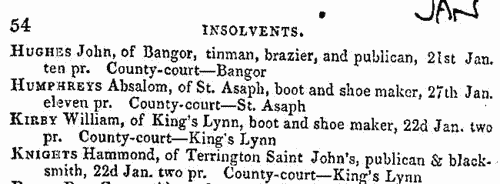
| Pupil Teachers in Lanarkshire: Boys
(1851)
The Committee of Council on Education awarded annual grants for the training and support of pupil teachers and stipendiary monitors in schools in England, Wales, Scotland, the Isle of Man and the Channel Islands. Pupil teachers started training between the ages of 13 and 15, and 'must not be subject to any bodily infirmity likely to impair their usefulness as Pupil Teachers, such as scrofula, fits, asthma, deafness, great imperfections in the sight or voice, the loss of an eye from constitutional disease, or the loss of an arm or leg, or the permanent disability of either arm or leg, curvature of the spine, or a hereditary tendency to insanity'.
They also had to obtain certificates from the managers of the school (and their clergyman, in the case of Church of England schools) as to their moral character and that of their family; good conduct; punctuality, diligence, obedience, and attention to duty; and attentiveness to their religious duties.
This detailed statement in the annual report of the committee for the year ending 31 October 1851 lists schools by county, giving:
1. Name and Denomination of School, with these abbreviations - B, British and Foreign School Society; F. C., Free Church of Scotland; H. C., Home and Colonial School Society; N., National Society, or connected with the Church of England; R. C., Roman Catholic Poor-School Committee; Wesn., Wesleyan Methodist.
2. Annual grants conditionally awarded by the committee in augmentation of teachers' salaries, and in stipends to apprentices, and gratuities to teachers.
3. Month in which annual examination was to be held.
4. Names of apprentices, giving surname and initials, and year of apprenticeship. Stipendiary monitors are indicated by (S. M.).BLANE. Cost: £6.00.  | Sample scan, click to enlarge
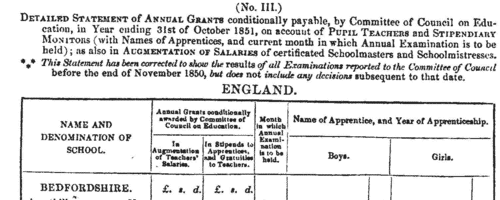
| Traders and professionals in London
(1851)
The Post Office London Directory for 1851 includes this 'Commercial and Professional Directory', recording about 80,000 individuals. BLANE. Cost: £4.00.  | Sample scan, click to enlarge

| Boys entering Cheltenham College
(1852)
Cheltenham College 'was founded in order to provide for the sons of gentlemen a Classical, Mathematical, and General Education of the highest order, on moderate terms, in strict conformity with the principles and doctrines of the Church of England.'
Andrew Alexander Hunter, the college registrar, compiled the first edition of the College Register in four parts from 1883 to 1886: these merely listed the boys by term of entry, with their dates of birth and names and addresses of their fathers. Circulars were also sent out to all Old Cheltonians whose addresses were known, requesting additional details. On the basis of the returns from these and Hunter's further researches, this much fuller register was published in 1890.
The information after each boy's name is given (where known and applicable) in this format: father's full name and address as of the time the boy entered the college; class and department on entering the college (classes being number from 1 downwards, and these again divided into A and B, some into C and D, others into P (Principal's side) and V. P. (Vice-Principal's side) - 1A was the highest class in each department: besides this, certain others were called Addiscombe, Woolwich, Civil, Direct, Line, Sandhurst, Naval, Special, Preparatory, Latin, and India Civil) and the same on leaving, name of Boarding House (or 'Day Boy'), scholastic and athletic honours attained at the college, and subsequent career (including date and place of death, or present address in 1890, if known).BLANE. Cost: £4.00.  | Sample scan, click to enlarge
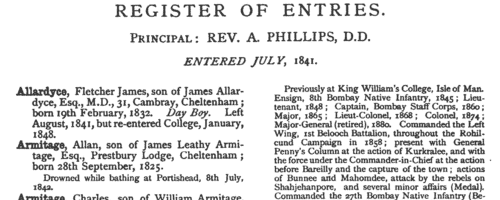
|
Research your ancestry, family history, genealogy and one-name study by direct access to original records and archives indexed by surname.
|













